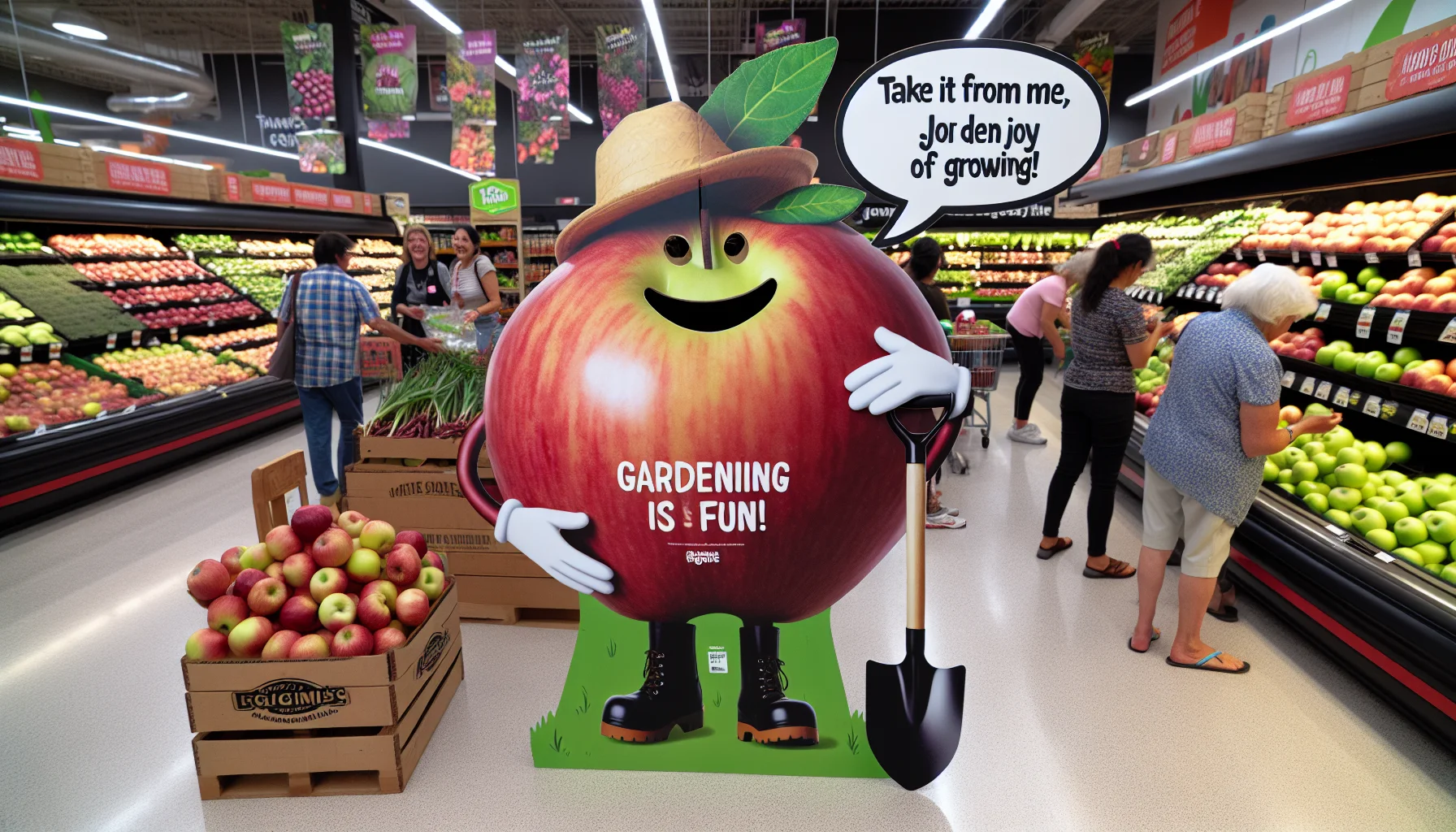Apples grocery Quiz
Test Your Knowledge
Question of
The Essential Guide to Growing Apples for Your Grocery Needs
Growing your own apples can significantly enhance your grocery shopping experience, offering numerous benefits that go beyond just having fresh fruit on hand. Firstly, it ensures that you have a steady supply of organic and pesticide-free produce, allowing you to enjoy healthier and tastier fruits straight from your backyard. Additionally, cultivating your own apple trees can lead to substantial savings on grocery bills over time. It also provides an opportunity to engage with nature and learn more about the process of growing food, which can be a rewarding and educational experience for individuals and families alike. Furthermore, home-grown apples can be used in a variety of recipes, ensuring you always have a versatile and nutritious ingredient at your disposal.
Choosing the Right Apple Varieties for Your Garden
When planning to grow apples in your garden, it's crucial to choose varieties that not only thrive in your climate but also meet your grocery needs. Different apple varieties have varying requirements for chill hours (the amount of cold weather they need to produce fruit), resistance to diseases, and preferences for sunlight and soil type. Additionally, consider whether you're looking for apples for fresh eating, cooking, or storing. Selecting the right types ensures a bountiful harvest that matches your expectations and culinary desires.
- Honeycrisp - Known for its sweet taste and crisp texture, perfect for eating fresh.
- Granny Smith - A tart variety, excellent for baking and cooking.
- Fuji - Offers a sweet flavor and a long shelf life, making it great for storage.
- Gala - Sweet and aromatic, ideal for snacking and salads.
- Braeburn - Has a unique combination of sweet and tart, suitable for various uses.
- Golden Delicious - Sweet and mellow, versatile for both eating fresh and cooking.
Planting and Caring for Your Apple Trees
Planting apple trees can be a rewarding experience, yielding fruit for years to come. To start, you need to select a suitable location. Apple trees thrive in full sunlight and require well-drained soil. Before planting, test your soil's pH; apple trees prefer a pH between 6.0 and 7.0.
Soil preparation is crucial for the healthy growth of apple trees. Loosen the soil to a depth of at least 12-18 inches and mix in organic matter to improve fertility and drainage. If your soil is heavy clay or too sandy, adding compost can help achieve the desired texture and nutrient balance.
When it comes to planting distances, space your apple trees about 15-20 feet apart. If you're planting dwarf varieties, 10-15 feet should suffice. This spacing ensures adequate air circulation and sunlight, reducing the risk of disease.
After planting, regular care is essential for your apple trees to thrive. Water your new trees deeply once a week, allowing the water to penetrate the soil deeply. This encourages deep root growth. Adjust your watering schedule based on rainfall, as overwatering can be as harmful as under-watering.
Pruning is another critical aspect of apple tree care. Prune your trees during the dormant season to remove any dead, damaged, or diseased branches. This helps the tree focus its energy on producing healthy growth and fruit. Additionally, proper pruning improves air circulation and sunlight penetration within the canopy, further reducing disease risk.
With the right care, your apple trees will become a bountiful source of delicious fruit for many years. Remember to monitor for pests and diseases regularly, and take action promptly to address any issues. Happy planting!
Pest and Disease Management in Apple Gardening
Apple trees, while rewarding, can be vulnerable to a variety of pests and diseases that threaten their health and productivity. Common issues include apple scab, caused by the fungus Venturia inaequalis, and pests like the codling moth, which targets the fruit itself. Powdery mildew, fire blight, and apple rust are also prevalent challenges that can affect the leaves, stems, and fruit of apple trees.
Eco-friendly management practices are essential for maintaining healthy apple gardens without relying heavily on chemical interventions. Here are some sustainable approaches:
- Regular Monitoring: Keep a close eye on your trees for early signs of pest and disease infestation.
- Cultural Controls: Implement practices such as proper pruning, sanitation, and choosing disease-resistant apple varieties.
- Biological Controls: Encourage or introduce natural predators of common pests into your garden.
- Mechanical and Physical Controls: Use barriers, traps, and other physical methods to protect your trees from pests.
- Organic Pesticides: When necessary, opt for organic and less harmful pesticides to manage outbreaks.
Harvesting and Storing Apples
To determine when apples are ripe for harvesting, observe the apple's background color, which should shift from green to yellow or its mature color, depending on the variety. Also, ripe apples separate easily from the tree when lifted and twisted slightly. Another indicator is the taste and texture; a ripe apple will be sweet and crisp. Checking the seed color can also help; seeds turn dark brown as apples mature.
For storing apples and extending their shelf life, start by selecting only the best apples without any bruises or blemishes. Store them in a cool, dark place, ideally in a refrigerator or a cellar where the temperature is between 30-40 degrees Fahrenheit. Keeping apples in a plastic bag with holes for ventilation can also help retain moisture and keep them crisp. Remember, apples emit ethylene gas, which can hasten ripening in other produce, so it's best to store them separately from other fruits and vegetables. Regularly check stored apples and remove any that start to spoil to prevent the spread of rot.
Using Your Home-Grown Apples
Apples are a remarkably versatile fruit that can enhance a wide array of dishes, both savory and sweet. Whether you're baking them into a classic pie, cooking them down into a rich, spiced apple butter, or simply slicing them up for a fresh, crunchy addition to salads, the possibilities are endless. Their natural sweetness and crisp texture make them a favorite ingredient in kitchens around the world, offering a delightful contrast in flavors and textures that can elevate any meal.
- Apple Pie
- Apple Crisp
- Apple Butter
- Apple Sauce
- Fresh Apple Salad
- Apple Chutney
- Caramel Apples
- Baked Apples
The Environmental and Economic Benefits of Growing Your Own Apples
Growing apples at home is not only a rewarding hobby but also an effective way to reduce your grocery bills and carbon footprint. By cultivating your own apple trees, you can enjoy fresh, organic fruits without the added costs and environmental impacts associated with commercial farming and transportation. This practice promotes sustainability and offers a healthier alternative for your family, all while contributing to a greener planet.
| Aspect | Home-Grown Apples | Store-Bought Apples |
|---|---|---|
| Cost | Initial investment in tree and minimal yearly upkeep | Constant cost per pound |
| Environmental Impact | Low; reduces transportation and packaging waste | High; includes transportation, packaging, and agricultural chemicals |
| Health Benefits | Higher; can be grown organically without pesticides | Varies; potential exposure to pesticides and preservatives |
| Taste and Freshness | Superior; harvested at peak ripeness | Can vary; often picked before fully ripe to endure transport |












